Bone Regeneration deals with attempts to regenerate bone, ligaments and connective tissue attachments that support the teeth.
Much in the same way that gum tissue can be restored with soft tissue grafts, the same can be said for those patients who suffer from bone loss due to periodontitis. Bone in the jaw is kept strong and healthy when a healthy tooth is in its socket. However, when bone loss occurs the tooth has less support, can become loose and eventually be lost.
Guided Tissue Regeneration (GTR) attempts to regenerate lost periodontal structures, such as bone, ligaments and connective tissue attachments that support the teeth. Biocompatible membranes are used conjunctively with bone grafts for the regeneration to be successful.
If a tooth is lost, a patient may seek dental implants to restore his/her smile. However, even dental implants need a healthy jawbone before they can be placed. Guided Bone Regeneration (GBR) or Ridge Augmentation restores the bone before the placement of implants. Biocompatible membranes and bone grafts keep the tissue out, thus allowing the bone to grow.
The recent advances in technology have led to a higher success rate with this procedure, leading to bone formation and resolving the defect.
 1) After cleaning a special membrane is placed between the gum and bone.
1) After cleaning a special membrane is placed between the gum and bone.
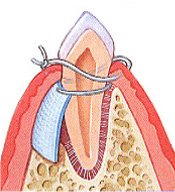 2) The membrane blocks tissue growth allowing ligament fibers and new bone to grow. Once root attaches to bone, the membrane dissolves.
2) The membrane blocks tissue growth allowing ligament fibers and new bone to grow. Once root attaches to bone, the membrane dissolves.
Emdogain
Emdogain is a grafting product that promotes the regeneration of hard and soft tissues lost through periodontal disease. Emdogain’s main ingredient is amelogenin, a protein that aids in the creation of teeth and supporting structures but produced only when our teeth are developing.
Emdogain is applied to the root surface. By doing so, the body thinks it is forming a natural tooth attachment, much like when your teeth first developed. Thus, the development of a natural tooth attachment and bone starts over.
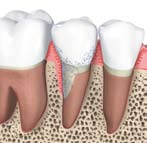
1) Deep periodontal defect with calculus on the root surface prior to regenerative treatment with Straumann Emdogain. Destruction of periodontal attachment and bone leading to loss of tooth support.
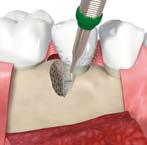
2) Mucoperiosteal access flap is reflected and Open Flap Debridement (OFD) is performed to completely remove plaque, calculus and granulation tissue as necessary.Straumann PrefGel® effectively removes the smear layer.
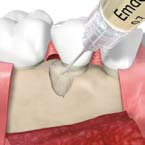
3) Application of Straumann Emdogain on the cleaned and conditioned root surface starting at the most apical bone level to cover the whole root surface. Enamel matrix proteins immediately precipitate and build a layer on the root surface, initiating the regeneration process.
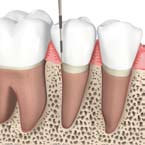
4) Successfully saved tooth through regeneration of periodontal tissue 6 to 12 months afterStraumann Emdogain treatment. The regenerative process of surgically treated areas should not be disturbed by probing for 6 months after treatment.

